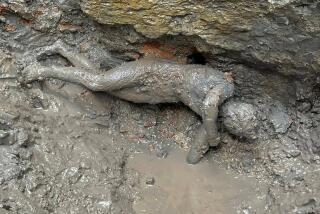Egyptian Workers Find 2 Huge Stone Statues Buried by History
- Share via
CAIRO — Construction workers digging a foundation for a post office struck a huge, long-hidden statue of Ramses the Great, an antiquities official said Saturday.
Egyptologists then discovered nearby the face of a second colossus staring up at them.
“So far, we don’t know who it is, but the face is huge,” said Yahya El Masri, antiquities director for Middle Egypt’s Sohag district. He said the first statue has the markings of Pharaoh Ramses II, whose 67-year rule ended in 1224 BC.
The granite statues were discovered three weeks ago at Akhmim, an ancient provincial capital across the Nile from modern Sohag, 290 miles south of Cairo. Both statues have been covered to prevent vandalism.
Neither statue has been fully measured, but judging from the width of the Ramses statue--6 1/2 feet--it’s monumental, El Masri said. He estimated its height to be at least 23 feet.
The statues are about 33 feet apart, but portions of each statue lie beneath graves in a Muslim cemetery, preventing further excavation for now. A possible solution would be to move the graves to another area, El Masri said.
The discovery suggests that the post office site was a temple complex during the reign of Ramses, who built more buildings and ordered more large statues carved in his honor than any other Egyptian king.
The largest known Ramses colossus lies in pieces inside the Ramesseum, his mortuary temple on the Nile’s West Bank opposite present-day Luxor. The fallen Ramses is estimated to have stood nearly 60 feet tall and weighed more than 1,000 tons.
When work began on the post office foundation, antiquities officials watched closely, El Masri said.
“We expected to find something, because it’s a known antiquities area and near to old sites,” he said.
Ancient Akhmim was an important provincial district containing the pharaonic city of Ipu. But Akhmim has not been popular with excavators, possibly because the city’s temples were dismantled in the Middle Ages for construction materials.
More to Read
Sign up for Essential California
The most important California stories and recommendations in your inbox every morning.
You may occasionally receive promotional content from the Los Angeles Times.










